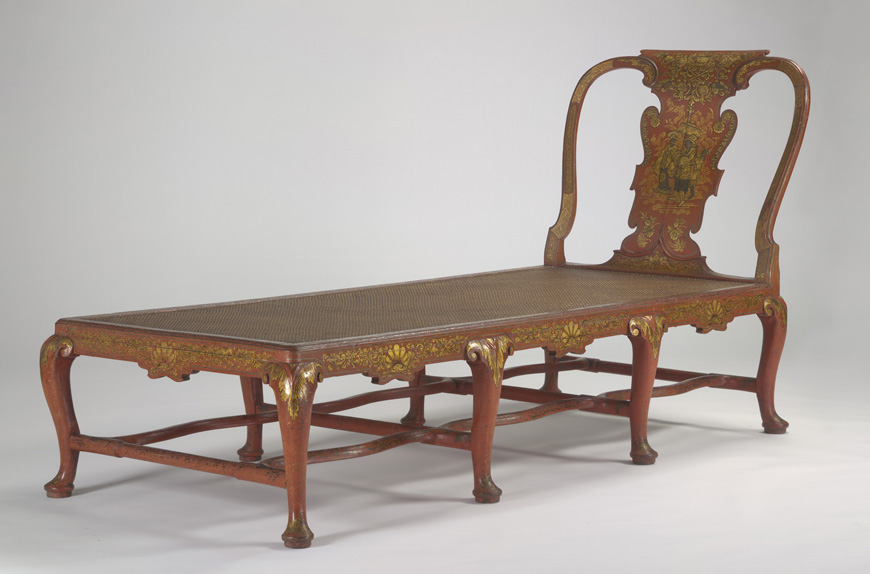As with many objects that were or still are functional, antique furniture and other wooden objects in decorative arts collections within museums or in private hands require special care.
Items of furniture are often complex structures that are comprised of different materials each with their own conservation needs. Such materials could include metals, textiles and other upholstery, leather, plastic, glass, ceramic, ivory and metal leaf. Understanding the composition of different kinds of wood, finishes, stains, paints and other materials on furniture and wooden objects can provide the best care.

Grendey day bed, photo courtesy of National Gallery Victoria
Types of deterioration
Wood is composed of cellulose, a hygroscopic organic material, meaning it has an affinity for water. It is very susceptible to reaction when exposed to fluctuating levels of temperature and relative humidity.
Low relative humidity (dry air) results in wood drying and shrinking. High relative humidity (damp air) introduces dampness to wooden objects which in turn causes them to expand. When an environment changes rapidly, complex objects such as items of furniture may not be able to withstand the repeated contracting and expanding and results in splitting or cracking.
Exposure to ultra-violet radiation in light can cause discolouration to wooden objects and furniture, and disintegration to other organic materials containing dyes such as textiles. Exposure to light can turn light woods dark, and conversely, bleach dark woods. Light can also cause brittleness or discolouration to the painted, stained or varnished layers on furniture.
As with other organic materials, wood is particularly susceptible to insect damage. Pests such as wood boring insects are attracted to certain kinds of timber and damp conditions can also encourage mould growth.
The functionality of furniture means they are often subject to mishandling or gradual wear and tear over time. Loss of parts, breakage and wearing down of structural components is a common result of usage in furniture. Dirt, stains and minor spills from water that result in cloudy patches on furniture demonstrate damage but also show the history and usage of items of furniture.
Treatment
Maintaining a stable environment without fluctuations in temperature or relative humidity and without direct exposure to light is an important step in preserving furniture and other wooden objects. If an environment is stable in relative humidity (between 40-60% relative humidity), wooden objects will not dry out and subsequently will not require oiling or waxing.
Inspecting furniture and wooden objects for signs of insect activity can be done by examining the insides of wooden components of furniture such as drawers and beneath linings for frass or exit holes that insects might leave. If insect activity is observed, isolate the furniture by wrapping in plastic and consulting a pest expert or a conservator is necessary.
Cleaning of furniture and wooden objects should be done with a clean, dry duster on large surfaces, or using fine brushes to dust intricate surfaces.
Metal components of furniture should be buffed with a clean, dry cloth. Commercially available products for metal and for furniture can leave residues over time and have unwanted effects.
Damage caused by mishandling or moving can be avoided by taking care when shifting furniture and assessing the strongest and weakest part of the object.
Conservators who specialise in furniture and other wooden objects are able to identify the requirements of different kinds of wood and materials that are found in furniture from different times. Furniture that needs repair or extensive cleaning should be referred to a conservator in order to achieve the best possible outcome.
AICCM has a Special Interest Group for those interested in the conservation of objects, which includes furniture and other wooden objects. Join this group, contribute to its activities, or speak to a specialist conservator.
Need a conservator? Find one here.
Resources
- Biological deterioration & damage to furniture & wooden objects (Smithsonian)
- The care and preservation of furniture and wooden objects (The Henry Ford)
- Care and Conservation of Furniture (Conservation Register, UK) [PDF – 65KB]
- Preserving Objects (National Archives of Australia)
- How to care for wood and furniture (CCI)